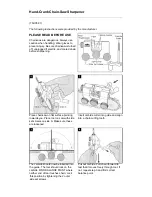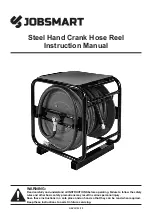
36 · www.tjep.eu
The RE-BAR tier starts itself without be-
ing activated.
Do not use the RE-BAR tier without cor-
recting the fault.
If it is not possible to correct it, contact
your dealer.
4.1.14. Do not make any modifications to
the RE-BAR tier.
Modifying the RE-BAR tier does not only
reduce the function of it, but also the level
of security. Do not make any modifications
to the RE-BAR tier.
4.1.15. Make sure that the RE-BAR tier is
in good condition.
To maintain the functionality and the quality
from the work of the RE-BAR tier, maintain
it properly and make sure that it is being
serviced on a regular basis. Remember to
keep the handle free of oil and dirt.
4.1.16. Use only approved batteries.
Use only the approved type of battery LI-
300 for this RE-BAR tier. If using another
power source, for example another type
of battery, dry cell battery or a car battery,
the machine can break down or burst into
flames.
4.1.17. Charge the batteries before use.
A new battery or a battery which has not
been used for a long period of time, may be
discharged and has to be fully recharged
before use.
4.2. Precautions in connection
with battery charging, chargers
and batteries.
4.2.1. Use only approved charger.
Use only the approved charger which
comes with the RE-BAR tier and batteries.
The batteries cannot be recharged with
other chargers – this may cause damage,
overheating or fire.
4.2.2. Recharge the batteries with the
correct voltage.
Make sure that the charger is connected
to an ordinary 100-240V outtake. Using
another voltage than 100-240V will cause
a malfunction and/or overheating, causing
damage to the battery and charger.
4.3.3. Never use a booster-type trans-
former.
4.2.4. Never charge the battery in a wet
or damp environment.
Charging in these conditions may cause an
electric shock or short circuit.
4.2.5. Do not touch the plug or charger
with a wet hand or glove.
You will risk injury from electric shock.
4.2.6. Do not place anything on the
charger during use.
The charger may become overheated and
eventually catch fire.
4.2.7. Make sure not to place charger
and battery next to a heating source or
open fire.
4.2.8. Do not place the battery near
flammable items.
4.2.9. Charge the battery in a well venti-
lated place.
Avoid placing it in direct sunlight.
4.2.10. Charge the battery at a tempera-
ture b5° and +40° Celsius.
4.2.11. Leave the charger to rest be-
tween charges.
4.2.12. Keep the charger’s connectors
clean.
All objects on the connectors can cause
electric chock or malfunction. Use the
charger in a dust- and dirt-free environ-
ment.
4.2.13. Handle the charger cord care-
fully.
Do not carry the charger in the cord, and
do not unplug it by pulling the cord. You will
risk that the cord becomes damaged and
will cause a malfunction. A damaged cord
must be replaced or repaired.
4.2.14. Put the cap on the battery con-
nectors when not in use.
This must be done to prevent a short circuit
in the battery.
4.2.15. Make sure that the battery con-
nectors do not touch each other.
A short circuit between the connectors will
overheat and damage the batteries.
















































